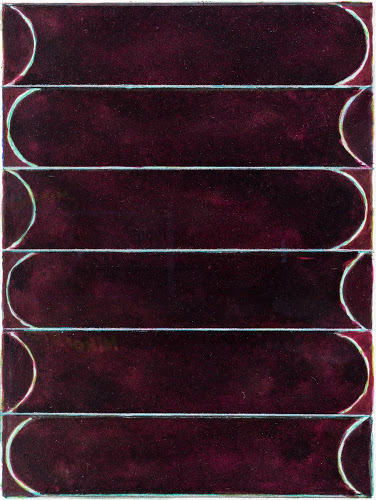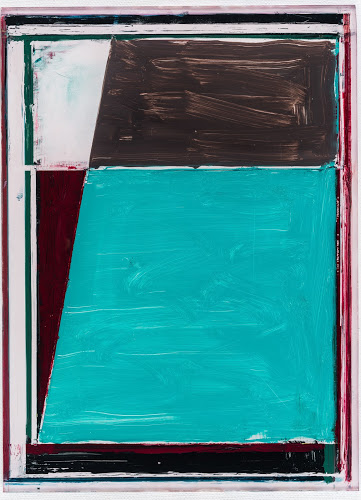
Contributed by Mira Dayal / Pastel balloons pregnant with helium shimmer in front of angular shadows cast from unseen objects in a photograph of a small room. In a nearby painting, these shapes morph into colorful arcs and elbows that playfully mimic the photograph’s composition. The candid titling of the first work, Untitled (DSC_1482) (2016), probably taken directly from the camera’s output, matches the candid curation of the show. With photographs hung alongside paintings, “Inside a Palm Field” at Pablo’s Birthday makes clear how the painter, Pius Fox, translates forms between works.




At the start of the show hangs Studio 8# (2015), a photograph of beams of light horizontally striping the floor. An area of lighter shadows forms a crooked rectangle in the top left corner while a more organic form darkens the top right corner of the image. This compositional structure is visually echoed is several paintings�most clearly in Untitled (PF-063) (2016), which is composed of horizontal stripes of similar tones; Untitled (PF 16-172) (2016), where the stripes become vertical and still dominate the canvas but are interrupted by lighter regions across the top and bottom; and In der Ferne die Wildnis (2016), which is composed entirely of vertical stripes alternatively light and dark.� More complex interpretations of Studio 8# can be seen in works such as Spurensuche (2016), which continues the pattern of horizontal stripes but also includes intersecting rectangular regions like that in the top left corner of the photograph. (The title Spurensuche translates roughly to “The Search for Traces,” which enforces the suspicion that the paintings derive from other sources.) In several of these painted works, the thin white edge of the photograph’s border on paper evolves into a colorful border that highlights the derivation of the form. The photograph’s grain, or perhaps the fibers of its paper, is exaggerated with the fine ridges of paint built up on several of the canvases.


While the above connections could perhaps be dismissed as merely coincidental, or resulting from Fox’s interest is abstracted forms rather than an actual transference of photo to painting, two works in the upstairs gallery are necessarily linked by virtue of a human gesture: the pointing finger. Untitled (2010) appears at first to be a photograph of a painted mural. A woman is seated in front of a fire, and the index finger of her right hand points outside of the image, towards the top right corner.� But just in front of this mural are a man’s feet, clearly more “real” than the woman. He is perhaps seated on a bed adjacent to the wall of the mural; his toes nearly touch the area where her torso would be. Her painted hands speak to his imaged feed�an intruding leg and arm across her shoulder could almost be his. Though the woman’s eyes look in the opposite direction of her finger, the viewer’s eye is trained to follow the gesture. There, adjacent to the image, is another painting whose composition was undoubtedly drawn from the photograph. The nebulous regions left by wrinkled sheets and underexposed blacks solidify into thin triangles, rounded trapezoids, and combinations of tangrams.


In another pleasing modal relationship, Connected / Disconnected VII (2016), a print of a statue of a man holding a woman�both nude, in a neoclassical pose�hangs opposite a large canvas titled Raumverschachtelung (2016), composed of shapes in baby blue, cream, navy, and light pink. Here the exchange is made more obvious than in the aforementioned comparisons by the addition of oil paint to the print in a color similar to the painting’s cream. In the oil composition, the angle of the woman’s leg against the man’s groin becomes a pentagram and the tension between their two heads as she pulls away is reflected in a straight diagonal line cutting across the top of the painting. �A translation of the title as “Space Interleaving” suggests that Fox was indeed interested in translating a sculptural form into a flattened spatial diagram.


The paintings comprising�”Inside a Palm Field” do seem to be weighted as Fox’s ultimate works, somehow more final than the other media, given their quantity and explicit titling as well as the direction of formal exchanges. Some might be compared to a simplified Kandinsky or Moholy-Nagy composition due to their vibrating colors and elemental forms. Such art historical references only add to the richness of the paintings’ dialogic existence. The forms surrounding the artist and fueling his paintings are, of course, derived not only from birthday party scenes and studio lighting but also from murals, sculptures, and art historical references. While many artists’ practices include inter-media relationships, the direct lineages presented here offer a refreshing illumination of the process of creation.
“Pius Fox: Inside a Palm Field,” Pablo’s Birthday, LES, New York, NY. Through�October 9th, 2016.
About the author:�Mira Dayal�is an artist,critic, and curator interested in exploring intersections�of�performance, identity, digital and outer space. In 2015, she launched�JAC,�a journal of art criticism.
Related posts:
Abstract Friday in Bushwick and the Bronx
Geometry is real
















